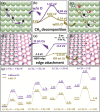The Way towards Ultrafast Growth of Single-Crystal Graphene on Copper
- PMID: 28932670
- PMCID: PMC5604388
- DOI: 10.1002/advs.201700087
The Way towards Ultrafast Growth of Single-Crystal Graphene on Copper
Abstract
The exceptional properties of graphene make it a promising candidate in the development of next-generation electronic, optoelectronic, photonic and photovoltaic devices. A holy grail in graphene research is the synthesis of large-sized single-crystal graphene, in which the absence of grain boundaries guarantees its excellent intrinsic properties and high performance in the devices. Nowadays, most attention has been drawn to the suppression of nucleation density by using low feeding gas during the growth process to allow only one nucleus to grow with enough space. However, because the nucleation is a random event and new nuclei are likely to form in the very long growth process, it is difficult to achieve industrial-level wafer-scale or beyond (e.g. 30 cm in diameter) single-crystal graphene. Another possible way to obtain large single-crystal graphene is to realize ultrafast growth, where once a nucleus forms, it grows up so quickly before new nuclei form. Therefore ultrafast growth provides a new direction for the synthesis of large single-crystal graphene, and is also of great significance to realize large-scale production of graphene films (fast growth is more time-efficient and cost-effective), which is likely to accelerate various graphene applications in industry.
Keywords: CVD; Cu foil; single crystal; ultrafast graphene growth.
Figures






Similar articles
-
Ultrafast epitaxial growth of metre-sized single-crystal graphene on industrial Cu foil.Sci Bull (Beijing). 2017 Aug 15;62(15):1074-1080. doi: 10.1016/j.scib.2017.07.005. Epub 2017 Jul 11. Sci Bull (Beijing). 2017. PMID: 36659334
-
Growth of Single-Layer and Multilayer Graphene on Cu/Ni Alloy Substrates.Acc Chem Res. 2020 Apr 21;53(4):800-811. doi: 10.1021/acs.accounts.9b00643. Epub 2020 Mar 24. Acc Chem Res. 2020. PMID: 32207601
-
Ultrafast growth of single-crystal graphene assisted by a continuous oxygen supply.Nat Nanotechnol. 2016 Nov;11(11):930-935. doi: 10.1038/nnano.2016.132. Epub 2016 Aug 8. Nat Nanotechnol. 2016. PMID: 27501317
-
Substrate Engineering for CVD Growth of Single Crystal Graphene.Small Methods. 2021 May;5(5):e2001213. doi: 10.1002/smtd.202001213. Epub 2021 Feb 5. Small Methods. 2021. PMID: 34928093 Review.
-
Controlled Growth of Single-Crystal Graphene Films.Adv Mater. 2020 Jan;32(1):e1903266. doi: 10.1002/adma.201903266. Epub 2019 Oct 3. Adv Mater. 2020. PMID: 31583792 Review.
Cited by
-
Chemical Vapor Deposition of Uniform and Large-Domain Molybdenum Disulfide Crystals on Glass/Al2O3 Substrates.Nanomaterials (Basel). 2022 Aug 7;12(15):2719. doi: 10.3390/nano12152719. Nanomaterials (Basel). 2022. PMID: 35957148 Free PMC article.
-
Growth of graphene with large single-crystal domains by Ni foam-assisted structure and its high-gain field-effect transistors.Nanoscale Adv. 2018 Dec 13;1(3):1130-1135. doi: 10.1039/c8na00203g. eCollection 2019 Mar 12. Nanoscale Adv. 2018. PMID: 36133206 Free PMC article.
-
Growth of Noncentrosymmetric Two-Dimensional Single Crystals.Precis Chem. 2024 Apr 5;2(7):330-354. doi: 10.1021/prechem.3c00122. eCollection 2024 Jul 22. Precis Chem. 2024. PMID: 39473902 Free PMC article. Review.
-
Simultaneous Growth Strategy of High-Optical-Efficiency GaN NWs on a Wide Range of Substrates by Pulsed Laser Deposition.ACS Omega. 2023 Dec 1;8(49):46804-46815. doi: 10.1021/acsomega.3c06302. eCollection 2023 Dec 12. ACS Omega. 2023. PMID: 38107938 Free PMC article.
-
Epitaxy of 2D Materials toward Single Crystals.Adv Sci (Weinh). 2022 Mar;9(8):e2105201. doi: 10.1002/advs.202105201. Epub 2022 Jan 17. Adv Sci (Weinh). 2022. PMID: 35038381 Free PMC article. Review.
References
-
- Novoselov K. S., Geim A. K., Morozov S. V., Jiang D., Katsnelson M. I., Grigorieva I. V., Dubonos S. V., Firsov A. A., Nature 2005, 438, 197. - PubMed
-
- Zhang Y., Tan Y. W., Stormer H. L., Kim P., Nature 2005, 438, 201. - PubMed
-
- Novoselov K. S., Geim A. K., Morozov S. V., Jiang D., Zhang Y., Dubonos S. V., Grigorieva I. V., Firsov A. A., Science 2004, 306, 666. - PubMed
-
- Zhang Y., Small J. P., Amori M. E., Kim P., Phys. Rev. Lett. 2005, 94, 176803. - PubMed
-
- Stankovich S., Dikin D. A., Dommett G. H., Kohlhaas K. M., Zimney E. J., Stach E. A., Piner R. D., Nguyen S. T., Ruoff R. S., Nature 2006, 442, 282. - PubMed
Publication types
LinkOut - more resources
Full Text Sources
Other Literature Sources
